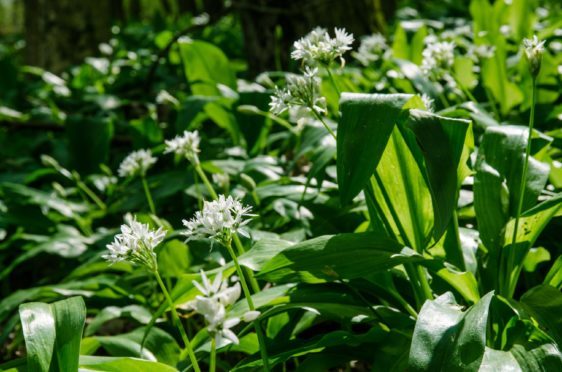Jamie Scott, chef patron of The Newport, finds ramson – or wild garlic – to be the perfect ingredient for spring dishes.
The end of the cold months is in sight as the longer, milder early spring days approach. To be honest, it hasn’t been that cold – the first wild garlic shoots of the year have already made an appearance through the wet dense frost-bitten ground. Now like most foragers and chefs we have our own wild garlic spot where we pick, but to honest it is quite common in Courier Country. Its Latin name is Allium ursinum and is also known as buckram, broad leaf garlic, bear leek or bear’s garlic. My personal favourite, however, is ramson. I love how raw and wild the word sounds and it tends to be what we use on our menu – it’s a wild relative of chives but mainly its part of the onion family as it so, so delicious and versatile.
Its leaves are bright green and beautifully shaped, growing between 45-50cm. Later in the season the buds sprout into beautifully edible white flowers. I did a little research and it was commonly used throughout Europe as a spring tonic due to its blood-purifying properties and is also thought to lower cholesterol. Despite its strong scent, wild garlic has a mellower taste than conventional garlic. Easily confused prior to flowering with the similar-looking poisonous lily of the valley, if you aren’t sure, ask an expert.
What do we do with it? Well, there are loads of options because it has different parts you can use. Dig up the roots and bulbs like conventional garlic, use the flowers in a pickle or a zing up a salad or garnish a light linguini. Whizz up the leaves with walnut, olive oil and some parmesan to make a delicious pesto. Better still you can create a lovely spring soup from the leaves. Sautee some white onion in butter until soft, add a peeled and freshly diced potato, one bay leaf and a sprig of thyme, after five minutes of cooking add half a litre of vegetable stock and cook until the potato is soft. Add a bunch of the ramson leaves and cook for 1-2 minutes, remove the bay leave and thyme and blend until smooth and vibrant green, season with fresh cracked black pepper and a spoonful of crème fraiche. Amazing!
As a business we look at all our food costs and when there is something so delicious and, in such abundance, it would be silly to ignore it and not use it, so we pick it twice a week and take about five kilos at a time. Our last little trick takes us back to the fermentation methods I have talked about before. Just before the flowers blossom we collect the bulbs and submerge them in a light pickle for 2-3 weeks which taste great on a charcuterie platter or with some of our buttermilk fried chicken. Then after the flowers have gone the bulbs start to spore and we pick the tiny green bulbs to be used in a pickle. They taste like capers, but are a lot cheaper to source – lovely on some smoked fish.
Chef’s tip
My tip this month is inspired by my lovely wife. She’s been cooking a lot more at home with our twin girls now eating proper meals. I gave her one of my good knives and want to share with you what I told her. Always keep your fingers tucked in on your non-dominant hand, using your upper knuckles to guide your knife as you slice. If your finger tips are tucked in you can’t cut them! And for the highest degree of control over your knife, hold the knife by the blade between your thumb and the side of your forefinger. To grip, use your middle, ring and pinkie fingers around the handle, for support and avoid laying your fingers over the spine of the knife. So far, no cuts!
www.thenewportrestaurant.co.uk











